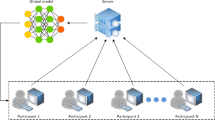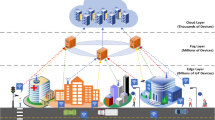Abstract
Highly scalable services are enabled by cloud computing and easily consumed over the Internet. User data is normally stored remotely in cloud services. Users do not own or operate the machines. This is a key feature of cloud services. Adoption of cloud services by the users are affected due to the fact that the users’ concerns about having to lose control on their own information and some attackers will hack them. Therefore to overcome the existing issues, this work proposed a new centralized cloud information accountability integrity with imperialist competitive key generation algorithm (CCIAI-ICKGA) is to resolve the above problems. It also provides the attack detection to monitor the practical utilization of the users’ information in the cloud environment. Second, cipher text-policy attribute-based encryption (CP-ABE) with key generation employing ICKGA and trapdoor generator is used to generate the public and private keys for every user. Third, the trapdoor generator ensures data integrity at the user level and also the cloud server level. At last, a dynamically weighted ensemble neural networks (DWENN) classifier is used for attack detection in the network. Additional guarantees of integrity and authenticity are provided by updating the structure of the log records. It is extended the framework in order to provide the security analysis which detects more possible attacks. Finally, a simulation result is carried out and renders a detailed performance analysis of the system. A result from rigorous experimental evaluation demonstrates the efficacy and resourcefulness of the novel CCIAI-ICKGA framework.








Similar content being viewed by others
Change history
01 June 2022
This article has been retracted. Please see the Retraction Notice for more detail: https://doi.org/10.1007/s12652-022-04012-7
References
Aiello M, Cambiaso E, Mongelli M, Papaleo G (2014) An on-line intrusion detection approach to identify low-rate DoS attacks. In: International Carnahan conference on security technology (ICCST) pp. 1–6
Atashpaz-Gargari E, Lucas C (2007) Imperialist competitive algorithm: an algorithm for optimization inspired by imperialistic competition. IEEE congress on evolutionary computation, pp. 4661–4667
Bhushan K, Gupta BB (2019) Distributed denial of service (DDoS) attack mitigation in software defined network (SDN)-based cloud computing environment. J Ambient Intell Hum Comput 10(5):1985–1997
Chen D, Li X, Wang L, Khan SU, Wang J, Zeng K, Cai C (2015) Fast and scalable multi-way analysis of massive neural data. IEEE Trans Comput 64(3):707–719
Choi J, Choi C, Ko B, Kim P (2014) A method of DDoS attack detection using HTTP packet pattern and rule engine in cloud computing environment. Soft Comput 18(9):1697–1703
Das R, Turkoglu I, Sengur A (2009) Effective diagnosis of heart disease through neural networks ensembles. Expert Syst Appl 36(4):7675–7680
Enayatifar R, Sadaei HJ, Abdullah AH, Gani A (2013) Imperialist competitive algorithm combined with refined high-order weighted fuzzy time series (RHWFTS–ICA) for short term load forecasting. Energy Convers Manag 76:1104–1116
Garkoti G, Peddoju SK, Balasubramanian R (2014) Detection of insider attacks in cloud based e-healthcare environment. International conference on information technology (ICIT), pp. 195–200
Gonzalez N, Miers C, Redigolo F, Simplicio M, Carvalho T, Näslund M, Pourzandi M (2012) A quantitative analysis of current security concerns and solutions for cloud computing. J Cloud Comput Adv Syst Appl 1(1):1–11
Harn L, Hsin WJ, Lin C (2010) Efficient on-line/off-line signature schemes based on multiple-collision trapdoor hash families. Comput J 53(9):1478–1484
He Z, Zhang T, Lee RB (2017) Machine learning based DDoS attack detection from source side in Cloud. Proceedings of the IEEE 4th international conference on cyber security and cloud computing (CSCloud), pp. 114–120
Hosseini S, Al Khaled A (2014) A survey on the imperialist competitive algorithm metaheuristic: implementation in engineering domain and directions for future research. Appl Soft Comput 24:1078–1094
Hwang K, Li D (2010) Trusted cloud computing with secure resources and data coloring. IEEE Internet Comput 14(5):14–22
Jaeger PT, Lin J, Grimes JM (2008) Cloud computing and information policy: computing in a policy cloud. J Inf Technol Politics 5(3):269–283
Khabbazi A, Atashpaz-Gargari E, Lucas C (2009) Imperialist competitive algorithm for minimum bit error rate beamforming. Int J Bio-Inspired Comput 1(1–2):125–133
Khan AN, Kiah MM, Madani SA, Ali M, Shamshirband S (2014) Incremental proxy re-encryption scheme for mobile cloud computing environment. J Supercomput 68(2):624–651
Kiraz MS (2016) A comprehensive meta-analysis of cryptographic security mechanisms for cloud computing. J Ambient Intell Hum Comput 7(5):731–760
Ko RK, Jagadpramana P, Mowbray M, Pearson S, Kirchberg M, Liang Q, Lee BS (2011) Trust Cloud: a framework for accountability and trust in cloud computing. IEEE World Congress on Services (SERVICES), pp. 584–588
Maqsood I, Khan MR, Abraham A (2004) An ensemble of neural networks for weather forecasting. Neural Comput Appl 13(2):112–122
Moore D, Shannon C, Brown DJ, Voelker GM, Savage S (2006) Inferring internet denial-of-service activity. ACM Trans Comput Syst 24(2):115–139
Noor TH, Sheng QZ, Alfazi A (2013) Reputation attacks detection for effective trust assessment among cloud services. IEEE international conference on trust, security and privacy in computing and communications (TrustCom), pp. 469–476
Nourmohammadi A, Zandieh M, Tavakkoli-Moghaddam R (2013) An imperialist competitive algorithm for multi-objective U-type assembly line design. J Comput Sci 4(5):393–400
Punitha AAA, Indumathi G (2018) Centralized cloud information accountability with bat key generation algorithm (CCIA-BKGA) framework in cloud computing environment. Cluster Computing, pp. 1–12
Punitha AAA, Indumathi G (2019) Centralized cloud information accountability integrity with Firefly Key Generation Algorithm (CCIAIFKGA) for cloud environment. Concurrency and computation: practice and experience, pp. 1–11
Reed A, Rezek C, Simmonds P (2011) Security guidance for critical areas of focus in cloud computing v3. 0. Cloud Security Alliance, pp. 14–44
Ren K, Wang C, Wang Q (2012) Security challenges for the public cloud. IEEE Internet Comput 16(1):69–73
Roughgarden T (2010) Algorithmic game theory. Commun ACM 53(7):78–86
Shamshirband S, Amini A, Anuar NB, Kiah MLM, Teh YW, Furnell S (2014) D-FICCA: A density-based fuzzy imperialist competitive clustering algorithm for intrusion detection in wireless sensor networks. Measurement 55:212–226
Sofi I, Mahajan A, Mansotra V (2017) Machine learning techniques used for the detection and analysis of modern types of DDoS attacks. Learning 4(6):1085–1093
Sreeram I, Vuppala VPK (2019) HTTP flood attack detection in application layer using machine learning metrics and bio inspired bat algorithm. Appl Comput Inf 15(1):59–66
Sundareswaran S, Squicciarini AC, Lin D (2012) Ensuring distributed accountability for data sharing in the cloud. IEEE Trans Dependable Secure Comput 9(4):556–568
Waters B (2011) Ciphertext-policy attribute-based encryption: an expressive, efficient, and provably secure realization. In: International workshop on public key cryptography, pp. 53–70
Wei L, Zhu H, Cao Z, Dong X, Jia W, Chen Y, Vasilakos AV (2014) Security and privacy for storage and computation in cloud computing. Inf Sci 258:371–386
Yang FY (2009) Improvement on a Trapdoor Hash Function. IJ Netw Secur 9(1):17–21
Author information
Authors and Affiliations
Corresponding author
Additional information
Publisher's Note
Springer Nature remains neutral with regard to jurisdictional claims in published maps and institutional affiliations.
This article has been retracted. Please see the retraction notice for more detail: https://doi.org/10.1007/s12652-022-04012-7"
About this article
Cite this article
Punitha, A.A.A., Indumathi, G. RETRACTED ARTICLE: A novel centralized cloud information accountability integrity with ensemble neural network based attack detection approach for cloud data. J Ambient Intell Human Comput 12, 4889–4900 (2021). https://doi.org/10.1007/s12652-020-01916-0
Received:
Accepted:
Published:
Issue Date:
DOI: https://doi.org/10.1007/s12652-020-01916-0




